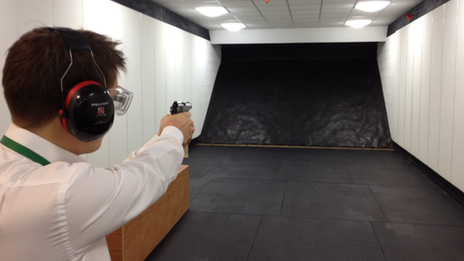'Antique guns' adapted by criminals facing weapons shortage
- Published
.png)
Hundreds of different weapons are kept in store at NABIS in Birmingham to be used to provide matches to crime scenes
.png)
Many of the weapons - like this Saint-Etienne army revolver - were brought to the NABIS centre rather than destroyed after successful prosecutions in the courts
.png)
NABIS said guns like this Russian made Baikal pistol were built to fire CS gas canisters and easily adapted to fire live 9mm ammunition
.png)
This Derringer style pistol was seized during the course of a police investigation
Antiques and obsolete guns are being adapted and used by criminals facing a shortage of weapons, according to police.
A decade ago, Britain's cities were experiencing a surge in gun crime but, following successful interventions by crime agencies and the government, the number of firearms offences annually is now half what it was in 2003, according to the Office for National Statistics.
One reason is the supply of weapons has been severely restricted, forcing criminals to seek out other means of sourcing guns.
The National Ballistics Intelligence Service (NABIS), established in 2008, helps police forces solve crimes in which guns have been used, identify individuals who import and supply them illegally, and track down people who are illegally converting or adapting them.
Go-to gun
On the firing range at its base in a Birmingham suburb, ballistics expert Greg Taylor shoots several rounds from a Russian-made Baikal pistol.
Built to fire CS gas canisters, they were easily adapted to fire live 9mm ammunition.
There was a period, a few years ago, where this was the go-to gun of choice for criminal gangs in the UK, but as a result of international co-operation between British and Russian authorities and those in the Baltic states, the supply has dried up.
But other weapons have taken its place.
In the laboratory next door cupboards are filled with evidence from active firearms investigations by the 28 police forces in England and Wales which NABIS serves.
On the desks are microscopes used by the ballistics experts to match bullets to weapons and in the armoury is a collection of hundreds of different weapons, kept in store in order to be used to provide matches to crime scenes.
Many were brought here rather than destroyed after successful prosecutions in the courts.
One is the Hungarian Feg pistol which was used during an incident where West Midlands Police officers were attacked during the riots in 2011.
They came under fire from gang members outside the Barton Arms pub in Aston.
As a result, 10 people were jailed, including Beniha Laing and Wesley Gray, who were sentenced to 35 and 29 years respectively.
'No licence required'
Another weapon seized after that attack was a French-made Saint-Etienne army revolver, used by the French Army in the 1870s.
Like many weapons of that era, spanning from the American Civil War until WWI, they can be legally imported as antiques.
Though they were built to fire ammunition that is now obsolete, they can be adapted to fire modern bullets.

Greg Taylor on the shooting range at the NABIS
"You can buy a weapon like that because it's of obsolete calibre, there's no licence required, and criminals are converting or modifying ammunition to fit," said Mr Taylor.
As we are discussing the problem, a new addition to the collection is brought in - a single shot Derringer-style pistol, which might have been carried by ladies in the late 19th Century for personal protection.
It is thought that a number of burglaries at antiques weapons collectors' homes across the country may have been ordered by gangs who are desperate to source new guns and rifles.
'Not free and easy'
There are stringent penalties for possessing a firearm, including imprisonment.
However, NABIS say there are now "armourers", who illegally provide guns for hire to gangs because of the shortage of supply.
In some cases, the same gun might have been used a number of times by different gangs in different cities.
"In the UK, getting your hands on a weapon is probably not as free and easy as it is in some countries," said Det Supt Iain O'Brien.
"So you have a situation where weapons can be used by different sides of a dispute."
The next potential threat in this country is the introduction of a gun which can be made using a 3D printer. It would not need to be imported.
When the ballistics expert tested one on the range, using a remote firing device and behind the safety of a bulletproof screen, it blew up.
It would probably have caused more damage to the person firing it than the one being fired at.
However, as crude as early versions are, they could become more sophisticated.
- Published6 May 2013
- Published9 May 2013
- Published14 January 2013